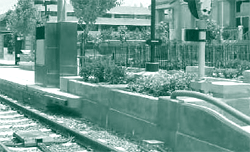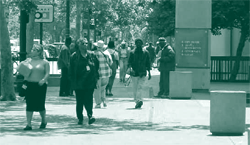December/January 2009
In this Issue
Closing the Distance Between Home and Work
Renewing Hope for Small Industrial Cities
A Clearer National Perspective on Homelessness
Helping Scholars Pursue Timely Research
In the next issue of ResearchWorks
Closing the Distance Between Home and Work
Trading long-distance commutes for lower housing costs is no longer a viable strategy for many low- and middle-income working families. In 28 metropolitan areas studied earlier this year, working households with incomes of $20,000 to $50,000 spent an average of 28 percent of their income on housing, plus an additional 30 percent on transportation.1 In March of 2007, Shelley Poticha, president of Reconnecting America, told the House Appropriations Subcommittee on Transportation, Housing and Urban Development, "While finding a cheaper house in the suburbs used to be a strategy that resulted in savings, recent studies show the increased cost of transportation nearly wipes that savings out." The growing dilemma for working families is that affordable housing and transit choices are limited, and available jobs are often too far from affordable residential areas.

This problem underscores the importance of preservation and new development of transit-oriented housing. HUD's Office of Policy Development and Research (PD&R) recently highlighted two research reports that investigate the impact of housing near public transportation. One study assesses the amount of federally assisted affordable housing currently located near public transportation in eight cities — Boston, Chicago, Cleveland, Denver, New York, Portland, St. Louis, and Seattle. In these metropolitan areas, researchers found 300,000 individuals living in 100,000 federally assisted housing units located within a half mile of actual or planned rail stations.2
Sixty-three percent of these units receive federal rental assistance through contracts that will expire before 2013. If the property owners decide to withdraw these units from federal assistance programs to take advantage of attractive market prices, these units will be lost to the low-income families and elderly citizens who currently reside in them. The rental subsidies for more than 45,000 of these units fall below area fair market rents, which, according to research sponsored by PD&R, increases the probability of a unit being withdrawn from a subsidy program.3
The second report, by Good Jobs First, examines ways in which transit-oriented developments (TODs) can make both housing and employment easily accessible to working families with low and moderate incomes.4 A review of 25 of these projects scattered across 13 states found several approaches to TODs that were especially effective in addressing the needs of working families:
- Community coalitions that negotiate TODs to secure concessions from the developer;
- Community development corporations that also aim to improve the neighborhood; and
- Private developers that intentionally design TODs to benefit low-income households.

The report includes examples of these approaches, such as Cherokee-Gates in Denver, Colorado and Center Commons in Portland, Oregon. Cherokee-Gates is an example of a TOD with concessions from the developer negotiated by a coalition of community groups. The $1 billion, 70-acre, mixed-use project offers 2,500 housing units and 6 million square feet of retail, office, and entertainment space. The negotiating coalition was composed of community-based organizations that worked to keep the project responsive to community needs. As a result, the developer agreed to exclude big-box grocery stores, set aside 10 percent of sale units and 20 percent of rental units as affordable, pay the local prevailing wage to workers in privately funded infrastructure construction and maintenance jobs, provide favored consideration to contractors offering health benefits and apprenticeships, extend the city's living wage to privately employed security and parking staff, focus on hiring neighborhood residents, and adhere to stronger environmental cleanup standards.
Center Commons is the brainchild of a private developer intent on designing a TOD that benefits low-income households. This development features more affordable housing units than the city required. Situated on 5 acres and located within walking distance of a light rail line, this mixed-income TOD consists of 4 apartment buildings and 26 townhouses. The apartment buildings contain affordable units for 172 seniors and 60 families, as well as 56 market-rate units. The three-story condominium townhouses were built primarily for first-time homeowners and made available to both conventional and below-median-income buyers. A daycare facility and a play area for children are located onsite. The city gave income-qualifying households property tax abatements for 10 years because of their proximity to light rail. Center Commons won a 2001 HUD Secretary's Housing and Community Design Award.
These projects are part of a growing trend in developing transit communities — mixed-use infill projects located near transit systems — and preserving affordable housing close to public transportation. The protection of affordable housing near transit assumes increasing urgency as traffic congestion grows, the housing supply shrinks, and nearby housing markets begin to rebound. A study jointly funded by HUD and the Federal Transit Administration (FTA) found that proponents of mixed-income TODs must overcome significant obstacles if they are to prevail over exclusively high-end development. Some of these obstacles are high land prices, limited capital and funding, complex financing structures, lengthy processes for acquiring land and permits, parking requirements, and community opposition to density and affordable housing.5 The report suggests that governments should identify opportunities and incentives for TODs; remove regulatory barriers that inhibit mixed-income, mixed-use development; coordinate housing and transportation plans and funding; and strengthen local capacity, partnerships, and data collection.
To see how HUD and FTA are working together on these objectives, see Better Coordination of Transportation and Housing Programs To Promote Affordable Housing Near Transit at www.huduser.gov/publications/commdevl/transport_and_hsg.html.
1. Robert Puentes and Elizabeth Roberto, Commuting to Opportunity: The Working Poor and Commuting in the United States, March 2008, Brookings Institution (www.brookings.edu/reports/2008/0314_transportation_puentes.aspx).
2. Reconnecting America and National Housing Trust, Preserving Opportunities: Saving Affordable Homes Near Transit, 2007 (www.hud.gov/offices/cpd/about/conplan/savingtransit.pdf).
3. Econometrica, Inc. and Abt Associates, Multifamily Properties: Opting In, Opting Out and Remaining Affordable, U.S. Department of Housing and Urban Development, Office of Policy Development and Research, 2006 (www.huduser.gov/publications/affhsg/opting_in.html).
4. Sarah Grady and Greg LeRoy, Making the Connection: Transit-Oriented Development and Jobs, Good Jobs First, March 2006 (www.hud.gov/offices/cpd/about/conplan/todjobs.pdf).
5. Center for Transit-Oriented Development, Reconnecting America, Realizing the Potential: Expanding Housing Opportunities Near Transit, April 2007 (www.reconnectingamerica.org/public/reports).

